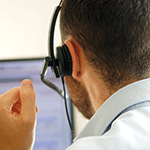Blog
Communications in the time of COVID-19: The unique role of pagers
In 2019, roughly 75% of hospitals were already supporting the use of pagers for communications. Now, during the COVID-19 pandemic, pagers have become more important than ever. With unmatched reliability and cost-effectiveness, the benefits of paging have, once again, brought the tried-and-true pager to the front of clinical communication conversations.
So, why exactly are pagers so crucial during times of crisis? And, what are some tips for using pagers to help with COVID-19 communications?
Pager tips during the COVID-19 crisis
As the largest paging network in the U.S., we’ve heard from many hospitals across the country on how they’re using pagers to help their communications run smoothly. With that in mind, here is a list of tips from our customers that can help you maximize the benefits of paging.
1. Use the affordability of pagers to limit the number of shared devices
Typically, some departments share or rotate devices among a group of people. Now, many customers are providing a pager to each staff member to limit contamination. It’s also now less convenient to share devices as the number of staff on shift has increased to meet the demands of the hospital.
2. Implement pagers quickly and effectively
Getting new or extra pagers up and running doesn’t require a lengthy implementation process. In fact, several hospitals across the country have added surge-based field hospitals (“pop-up” facilities) to provide more capacity to treat patients who have COVID-19. Adding paging as an essential communication tool in these new facilities is an efficient way to connect large care teams, especially if other communication tools don’t work outside the hospital.
For example, Partners Healthcare converted the Boston Convention Center to handle up to 1,000 more patients. Our field engineering team confirmed wireless signals were strong throughout the building and Partners Healthcare staff had the new space up and running quickly.
3. Swiftly onboard new staff
Many hospitals are ordering extra pagers to ensure their on-hand supply is enough to handle a surge in new staff. Pagers can easily support temporary staff joining your organization to augment clinical teams. Spok also offers a web-based pager management tool that helps hospitals facilitate all aspects of their paging program, including building ad-hoc groups as needed.
4. Create multiple areas to house paging equipment
Typically, healthcare facilities hold spare paging equipment onsite for immediate exchanges on a 24/7 basis. They often maintain equipment in operator service areas or within telecommunication departments. To reduce the risk of losing access to their spare equipment, hospitals have been creating multiple staging areas to house additional paging equipment. This ensures unrestricted access, allowing hospitals to provide these critical communication tools as needed.
5. Don’t forget the batteries!
It sounds simple, but it’s important. Ensure your facilities are maintaining an adequate supply of AA/AAA batteries. As personnel move throughout the institution, provide additional battery stations to better support your end users.
6. Remember, pagers aren’t fragile
Pagers are extremely durable. They are easy to clean, and low cost to replace and maintain.
Why are pagers still so crucial?
Our paging network delivers over 100 million messages each month. Surprised? The continued popularity of pagers in healthcare has surprised many people—yet they aren’t going anywhere anytime soon. Here’s why.
1. Unbeatable reliability
Though many hospitals use smart devices for communications, they are often complemented with paging because pagers are more reliable. Hospitals can be labyrinths of concrete and steel, and messages sent over spotty cellular or Wi-Fi coverage may not be delivered successfully. In addition, the Spok paging network offers 99.92% reliability, so you can be certain that the care team gets alerts or messages immediately.
During a crisis or disaster, pagers allow staff to continue communicating when networks are down, or operations are in crisis mode. Pagers work using a simple battery to connect to an extensive, highly reliable external network unrelated to any hospital servers or infrastructure.
2. The right device for the right role
At 53%, more than half of non-clinical staff—including housekeepers, transport technicians, dietary staff, etc.—still use pagers as their primary communication device for work. These roles typically don’t need EHR access, clinical decision support, or other clinically-focused applications, so the inexpensive pager fulfills their communication needs. A diverse device mix ensures each staff member has the mobile device best suited to the nature of their work and reduces service and maintenance costs.
3. Options for encryption
Whether you have clinical or non-clinical roles using pagers, all members of the care team likely have instances where they need to communicate protected health information (PHI) in their pages. Our proprietary encrypted pagers are fully secure and HIPAA-compliant, so care team members can safely send any and all information needed to efficiently coordinate care, including patient name, DOB, room, condition, etc., without worry. Each message is fully encrypted with the industry-standard AES-128 encryption algorithm, and each device is programmed with a unique key. With the additional display-lock security features and remote data-wipe, the encrypted pager ensures fast, reliable, and secure communication.
When it comes to critical communications in healthcare, paging is still a powerful tool. In this incomparable time, we are here to do everything we can to support your critical healthcare operations.







